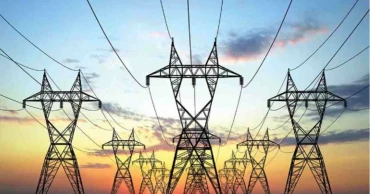load shedding
Power cuts plague Sylhet: Frustration growing among residents and businesses
In Sylhet city, frequent power outages are affecting the daily lives of its residents and the local economy. The city has experienced severe load shedding in recent days, impacting traders and disrupting the water supply managed by the city corporation.
Experts attribute the problem to a significant shortfall in power supply. The Sylhet region faces a gap, with demand ranging from 140-160 MW against a supply deficit of 40-60 MW.
Shielding capital Dhaka from loadshedding masks reality of power cuts biting nation
The Sylhet Power Development Board's records reveal stark disparities: on April 2, demand hit 141 MW against a mere supply of 56 MW; April 3 saw demand at 120-130 MW with only 66 MW supplied; and on April 4, the supply was just 69 MW against a demand of 135 MW.
As Eid-ul-Fitr approaches, traders, in anticipation of the festive rush, have decorated their establishments, only to rely on generators amidst the frequent outages. The disruptions have also inconvenienced residents during crucial times like Sehri and Iftar.
Zakir Ahmed, a local trader from Golapganj, voiced the community's distress, stating, “General people and businesses are the worst sufferers, and we fear the power cut problems will only worsen with the summer heat.”
Echoing the sentiment, Airin Sultana Nipa, a housewife from Lala Dighirpar, shared her struggles, “The power goes out before dawn, causing water shortages at critical moments like Iftar and Sehri. It's disheartening to face such challenges.”
Days of sweltering heat, power cuts in northern India overwhelm hospitals as death toll climbs
Jarjisur Rahman Rony, an assistant engineer at the Sylhet Power Development Board, shed light on the dilemma, “We're distributing what little electricity we have. The issue isn't with the infrastructure but stems from broader economic challenges affecting power generation, such as the dollar and coal crisis, forcing us into load shedding.”
1 year ago
People suffer as severe load shedding continues countrywide
Severe load shedding continued across the country amid the sweltering heat.
As a result of power generation between 12,000 MW and 13,000 MW against the demand of nearly 16,000 MW, the people in capital Dhaka and elsewhere have been experiencing frequent power cuts that makes their lives unbearable in this peak summer when temperatures are soaring to 38-42 degree Celsius.
Also Read: Coal shortage forces Payra Power Plant to shut down operation
In the daytime power cuts already crossed 2,600 MW and it is apprehended that the outage may go up to 3,500 MW in the evening peak.
It is alleged that power supply situation is worse in the rural areas as they get electricity for 3-5 hours a day while the rest of the time they have to remain without electricity.
Also Read: Load shedding increases again with fall in power generation
Interestingly, the official data of the Power Grid Company of Bangladesh (PGCB) shows that the extent of load shedding reaches the highest peak at midnights when people remain in deep sleep.
The data also shows the country experienced 2610 MW while the demand for electricity was 14,900 MW and the generation output was 12,166 MW at 12 noon on Tuesday.
The power generation forecast at the evening peak was projected to be 14,900 MW against a projected demand of 15,800 MW when load shedding was planned for only 900 MW.
“But the reality is totally different”, said a top official at state-owned Bangladesh Power Development Board.
At the evening peak the extent of load shedding reaches 2700 MW to 3500 MW, he noted, saying the official data always does not reflect the ground reality.
Also Read: Power supply situation will improve in two weeks: Nasrul Hamid
However, the official data of PGCB, responsible for power transmission across the country, shows that the load shedding was 2815 MW at 4 pm, 2735 at 6 pm on Monday, 3266 MW at 1 am Tuesday.
The load shedding was 3215 MW at 1 am (midnight) and 3143 MW at 2 pm (midnight) on Tuesday.
Also Read: Frequent power cuts amid heat wave multiplies people’s woes
This means the extent of highest load shedding at midnight is a new phenomenon as though the country’s demand decreases at midnight, the power generation also decreases to a level of 11,000 MW.
Normally, no load shedding was seen in the midnights in the previous years. This year, load shedding at midnights has become regular.
No official from the BPDB was found to be willing to comment on the issue.
2 years ago
Imagine if electricity generation capacity were still 3000 MW like in BNP-Jamaat govt period: Nasrul Hamid
State Minister for Power, Energy and Mineral Resources Nasrul Hamid has shared an explanation on why load shedding has become more acute and frequent in Bangladesh as people struggle with the ongoing sweltering heat.
“People of Bangladesh are suffering during this scorching heat. Use of air conditioners and fans is increasing, and people are using these devices for comfort,” the state minister wrote in a post on his verified Facebook profile.
Read more: BTMA seeks smooth gas-electricity supply and loan moratorium to survive
On June 3, Bangladesh generated 13,635 MW of electricity, yet there was load shedding, he noted.
Imagine what would have happened in the country today if 3000 MW of electricity were being produced as was the case during the last BNP-Jamaat government, he wrote.
“The Awami League government has provided electricity to all the villages and cities in the country. This is a people's government, so the government wants to deal with this crisis with the cooperation of everyone,” Nasrul Hamid wrote in the post.
Read more: 1500 MW of electricity from solar systems can be generated in next 1 year: Speakers
He urged everyone to save electricity from their individual position.
2 years ago
Coal shortage forces Payra Power Plant to shut down operation
Payra Thermal Power Plant’s operations came to a complete halt at 12:05 pm today, with its second unit shutting down due to coal crisis.
The shutdown of the power plant worsened an already severe load shedding situation in Dhaka city and elsewhere, according to BPDB officials.
Earier, the other 660 MW unit of the power plant was closed on May 25.
BPDB officials said due to the shutdown of the second unit of Payra power plant, the country’s load shedding has increased to 2675 MW at 12 pm today, which was 2287 MW on Sunday.
It means the country had to experience 388 MW of added load shedding due to the closure of Payra power plant's operations, said an official of BPDB referring to the data of the National Load Despatch Centre (NLDC).
He said the country generated 12099 MW of electricity against a demand of 14900 at 12 pm today.
NLDC’s evening forecast shows that the country’s demand will go up to 15800 MW when generation is expected to be 14,400 MW.
Also Read: Coal shortage: Production at another unit of Payra power plant may suspend after June 2
However, officials said the country may experience more than 3500 MW of load shedding in the evening peak period
The 1,320 MW coal-fired power plant is expected to resume operations on July 1 as the process of importing coal has already started through the opening of LC, said Shah Abdul Hasib, superintendent engineer (operation) at the plant.
He said the shipment will arrive by June 25.
“After the shipment of coal arrives, we will be able to resume the plant’s operation by July 1,” he said.
He said opening LC takes some time due to the current global situation and dollar crisis.
Payra power plant needs to import 3 lakh metric tonnes of coal every month to operate the plant in full capacity.
Also Read: Operation of 1,320 MW coal-fired Payra power plant is likely to face closure over coal crisis
The power plant has to spend about US$ 5-6 million every month to import the required coal.
Payra power plant officials said the power plant is burning some 13,000 tonnes of coal a day. It has a 76.30-acre dumping zone where 25 years’ worth of by-products can be kept.
The plant is currently importing coal from Indonesia. It has its own jetty, whose conveyor belts can unload 3,200 tonnes of coal every hour from four vessels at a time.
After undergoing test runs for about five months, the first unit of the Payra power plant started commercial operation in May 2020. In October 2020, the second unit of the 660 MW plant, a joint venture of Bangladesh and China, started its commercial operation.
2 years ago
IPS Buyer's Guide with Price Ranges in Bangladesh
In Bangladesh, where frequent power outages or load shedding are common, having a reliable backup power solution is crucial. This is where an IPS (Instant Power Supply) or Home UPS comes into play. An IPS provides uninterrupted power to essential appliances and devices during power cuts, ensuring that crucial tasks can be carried out without interruption.
Whether it's running important medical equipment, operating computers, or simply keeping the lights on, an IPS is a necessity for households, offices, and businesses alike. Let’s explore the different types of IPS systems available in Bangladesh under various price ranges.
Things to Consider When Buying an IPS or Home UPS
When rushing to buy, customers often fall prey to the persuasive tactics employed by sellers, leading them to make ill-informed choices. To avoid such pitfalls, here are a few crucial factors to consider when purchasing an IPS/UPS system.
Terms and Works
It's important to understand the distinction between IPS and UPS. While both supply power during a mains power failure, UPS seamlessly switches the connection without any noticeable power drop, whereas IPS requires a minimum of one second or more to switch. Nowadays, most IPS systems come equipped with UPS functionality, allowing them to function interchangeably.
Read more: Top Charger Fans in Bangladesh in 2023
Types
When it comes to UPS systems, there are two types to choose from: online and offline. Offline UPS systems are more affordable but are better suited for short power outages. On the other hand, online UPS systems tend to be more stable and reliable, and the higher the price, the better the quality you can expect.
Power Coverage
Before making a purchase, it's crucial to calculate the power requirements of your devices and the number of connected devices. The IPS/UPS system may not perform optimally if the demand exceeds the supply. You can determine the wattage of each device by checking the information stamped on the appliance itself.
Warranty
Warranty is vital, as the lifespan of an IPS/UPS system is typically determined by the battery's longevity. Batteries usually last around two to three years, so it's important to check the warranty coverage provided.
Read more: Home Theater Buyer's Guide with Price Ranges in Bangladesh
Price
Price is undoubtedly a significant factor while choosing an IPS/UPS system. As a result, prospective buyers must exercise caution and consider their options carefully, as it represents a significant investment.
Selecting the right IPS/UPS system depends on identifying and aligning the essential features with your specific needs and budget. A clear understanding of what one is looking for will simplify one’s decision-making.
Features and Prices of Some Popular IPS/Home UPS Models Available in Bangladesh
Best IPS Under BDT 15,000
Luminous IPS Eco Watt Neo 1050 12V
The Luminous Eco Volt Neo 1050 IPS with a 200 AH battery is a product from the Luminous brand. It offers a sine wave inverter type with a capacity of 900 VA and a rated power of 756 W. This IPS supports a single battery and has a maximum charging current of 17A. The dimensions of the device are 27.5x26.2x12.0 cm. It comes with a 2-year warranty.
Read more: Inverter AC Prices in Bangladesh in 2023
The specially designed 200 AH lead-acid rechargeable battery ensures high energy density and heavy-duty performance. This IPS is ideal for 1000VA IPS/UPS standard use. The price of this product is BDT 11,999.
Rahimafrooz Power Pack 900VA
The Rahimafrooz Power Pack 900VA IPS is a versatile and efficient power solution. It functions as both a UPS and an IPS, offering dual-mode functionality. A pure sine wave output ensures a smooth and stable power supply. The inverter capacity is 900VA, with a rated power of 725 watts, allowing it to handle various electrical loads.
It includes a battery with a capacity of up to 200Ah, providing ample backup power. The IPS features overloading, overcharging, and short-circuit protection for enhanced safety. It can support 9 LED energy lights, 4 ceiling fans, 1 LED or LCD television, and 3 mobile chargers. The price of the Rahimafrooz Power Pack 900VA IPS in Bangladesh is BDT 13,000.
Read more: Air Cooler price in Bangladesh with Buying Tips
Smarten IPS-700VA
This reliable and powerful system, manufactured in India, is considered one of the best IPS in Bangladesh. With a capacity of 500 Watts, it can easily support up to 6 or 7 lights and 3 fans, ensuring a comfortable and well-lit environment during power cuts. The user-friendly design and efficient performance make it accessible to users of all technical backgrounds.
With a recommended 12-volt battery, you can enjoy uninterrupted power for extended periods. The Smarten brand is reputable and trusted in the electronics industry, known for delivering high-quality products that exceed customer expectations.
The Smarten IPS system is an excellent investment for your home or office, offering impressive features and reliable performance. It comes with a 2-year warranty, and the price is BDT 14,000.
Read more: Dhaka alone experiencing over 600 MW of load shedding during daytime
2 years ago
Dhaka alone experiencing over 600 MW of load shedding during daytime
Dhaka has alone been experiencing more than 600 MW of load shedding during daytime when demand for electricity remains relatively low than nighttime.
According to official sources, like the previous few days the country has been seeing over 2000 MW of power shortage.
As a result, consumers across the country are facing power outages for 6 to 7 hours in different spells during the day.
Also Read: After record, country’s power generation again drops below 15,000 MW
“After the evening, the situation will be deteriorating with the increase in demand,” said a top official of the Bangladesh Power Development Board (BPDB) preferring anonymity.
He attributed the gas shortage for the severe situation in power supply.
“Actually, we have been getting lower supply of gas that forced us to keep at least 25 generation units across the country shut,” he said.
Also Read: Load shedding in Sylhet: PDB engineer receives threat; GD filed
He, however, said that if the BPDB receives normal supply of gas, it can produce 6,500 MW of electricity from its gas-fired plants.
“But now we’re producing 4667 MW and about 1,833 MW of electricity is not available for gas shortage,” he noted.
Meanwhile, managing director Dhaka Electric Supply Company (Desco) Md. Kausar Ameer Ali said that the area under the organization was experiencing a load shedding of 308 MW in the daytime.
Read more: Gap between power generation, supply widening: Nationwide load shedding over 1500 MW
“The Desco is receiving about 800 MW against a demand of 1111 MW,” he told UNB.
Desco is entrusted with the responsibility to distribute electricity in Dhaka city’s north, north-west and eastern parts while Dhaka Power Distribution Company (DPDC) is responsible for power supply in the south, southeast and central part of Dhaka city.
DPDC Managing director Bikash Dewan said that area under DPDC has been experiencing a shortage of about 340 MW which might be up after the evening.
Also Read:Load shedding in Sylhet: PDB engineer receives threat; GD filed
He said DPDC has been resorting to load shedding of more than 340 MW to manage a demand of more than 1600 MW as it has been receiving 1250 MW.
However, consumers are complaining that they have to experience a huge load shedding.
In some areas, people are allegedly experiencing power outages just in every alternative hour.
Also Read: Load shedding amid intense heat wave makes life miserable in Khulna
“Power cuts are frequent and we have been experiencing load shedding in every alternative hour,” said Abdus Selim, a resident in the city’s Niketan area.
The same experience was shared by Nazim Uddin who lives in Moghbazar area.
State Minister for Power, Energy and Mineral Resources Nasrul Hamid on Sunday said that it will take two days to improve the power and gas supply situation in the country.
Also Read: Loadshedding becomes insufferable: Locals vandalise Palli Bidyut office in Feni
He said that after the suspension of gas supply from two floating LNG terminals, one terminal left its place for safe location while another one remained stationed at its own location.
The suspension caused a huge shortage in gas supply that triggered the current level of load shedding across the country.
“The current disruption in power and gas supply will improve as one of the two LNG terminals will resume supply within two days,” he told reporters at his office in the ministry.
Also Read: Record heat driving record power generation, even as loadshedding increases
“But I hope, gas supply will resume from one terminal within two days which will improve the situation with the supply of 400 mmcfd gas,” he said, adding that it will take 10-12 days to resume gas supply from the other LNG terminal.
2 years ago
After record, country’s power generation again drops below 15,000 MW
After making a record of crossing 15,300 MW of benchmark, the country’s overall power generation again declined to below 15,000 MW on Saturday.
According to official sources, the sudden shutdown of 660 MW first unit of Rampal Bangladesh-India Moitree power plant attributed to this fall in power generation.
However, no explanation was given by the Bangladesh-India Friendship Power Company Limited (bifpcl) in this regard which owns and operates the plant.
Meanwhile, the country has to experience more than 1000 MW of load shedding due to shortage in power generation.
Bangladesh Power Development Board (BPDB) official record shows that the country generated 13,996 MW on Saturday night against a demand of 15,000 MW.
The BPDB made a forecast for Sunday indicating that the country’ s peak demand would be 16,000 MW on Sunday while maximum generation will be 15,000 MW and there might be a load shedding of about 1000 MW.
BPDB officials said the government withdrew the suspension on power generation by diesel-fired power plants last week following the excessive rise in demand against the backdrop of rise in temperature.
“From last week we have been operating some diesel-fired power plants due to the rise in demand,” a senior official of the BPDB told UNB.
He also said currently about 700 MW diesel-fired power plants have been in the operation.
The government suspended diesel-fired power generation in July last year following soaring fuel price in the international market.
2 years ago
Power cut hits Khulna after production halted at Rampal plant over coal crisis
Khulna division has been experiencing acute load shedding even in the winter due to suspension of power production at Rampal Power Plant amid shortage of coal caused by the dollar crisis.
The production came to a halt on January 14, only after 27 days the coal-fired plant in Bagerhat started electricity generation by adding 660MW of electricity to the national grid produced from its first unit.
Khulna West Zone Power Distribution Company (WZPDC), which distributes power in Khulna and Barishal region, authorities have been struggling to meet the electricity demand although the demand for electricity comes to half in the winter.
Read more: Hasina, Modi jointly unveil Rampal Power Plant’s unit 1
On Thursday, the Khulna region experienced 24 MW load shedding in off-peak hours while during peak hours it was four MW. On Friday, the load shedding was 5 MW while the residents of different areas in the city experienced power outages, officials said.
Anwarul Azim, deputy manager of Bangladesh-India Partnership Power Company Ltd (BCPCL), said import of coal was suspended due to the crisis of US dollar that cut production by half on January 14.
BCPCL is a joint venture of the Chinese firm China National Machinery Import & Export Corporation (CMC) and Bangladeshi state-owned North-West Power Generation Company Bangladesh Limited (NWPGCL).
Rampal Power plant’s Unit-1 has a capacity of producing 660MW of electricity . Before suspension of production, its Unit-1 used to produce 560-570 MW.
Read more: Rampal Plant starts electricity production, 660MW from unit-1 added to nat’l grid
Of this, 400MW was added to the national grid via Aminbazar-Gopalganj transmission line and 260MW was added to Khulna-Bagerhat.
Around 5,000 tonnes of coal are needed for the operation of the power plant and all are imported from Indonesia but due to the dollar crisis the import of coal was suspended.
Anwarul Azim said banks did not allow opening of Letter of Credit (LC) for importing coal due to the dollar crisis.
“Already, a coal-carrying vessel from Indonesia is ready to leave for Bangladesh but we are trying our best to import coal. We hope the problem will be resolved soon,” he added.
2 years ago
Already battered by Covid-19, load shedding hits hard Kuakata tourism, fisheries sectors
Already hit-hard by the Covid-19 pandemic, when tourism and fisheries sectors in Kuakata are trying to make a recovery, frequent load shedding have dealt another blow.
Bearing the brunt are hotel and motel owners in Kuakata, wholesale fish traders in the district’s Alipur and Mahipur landing stations, and trawler owners.
When the government decided to stop buying liquified natural gas (LNG) from the international spot market because of a sharp price hike in July, the power supply situation began to deteriorate. Daily hour-long area-based load shedding started across Bangladesh from July 19, 2022 to tackle the ongoing energy crisis.
Owners of hotels, motels, ice mills and fish traders said they are counting huge losses due to incessant power cuts.
Read More: Kuakata Sea Beach, Bangladesh: Magnificent sunrise, sunset views to remember
Motaleb Sharif, General Secretary of Kuakata Hotel Motel Owners Association and Owner of Kuakata Guest House, said that the number of tourists in Kuakata is dwindling due to rampant load shedding.
“There are a total of 150 big and small hotels and motels in Kuakata. Although these establishments were abuzz with tourists, this isn’t the case anymore. We’re frustrated with up to six load shedding every day. Tourists are losing interest because of the inconvenience,” Motaleb said.
He added that although they had informed the Prime Minister’s Energy Advisor Tawfiq-e-Elahi Chowdhury about the problem and demanded establishment of a power sub-station in the area, no steps have been taken yet.
Rahim Khan, owner of Khan Palace, said that refrigerators and air conditioners are being damaged due to the frequent power cuts.
Read More: Dead dolphin washes ashore on Kuakata beach
“We have to spend more than what we earn from the boarders. We experience load shedding even on weekends, which is discouraging tourists. Although a 1320 MW thermal power plant has been set up in Payra, people of Patuakhali are yet to reap its benefits,” Rahim said.
3 years ago
Cyclone Sitrang: Many areas in Dhaka, Narayanganj plunge into darkness following disruption in power supply
Many areas in Dhaka and Narayanganj cities plunged into darkness following a huge disruption in power supply that authorities blamed on the approaching Cyclone Sitrang.
According to officials of the Dhaka Power Distribution Company Limited (DPDC) and Desco, the two entities which control the distribution network in Dhaka and Narayanganj, following a fault in Sympur, Ulan and Maniknagar grid line, many areas experienced blackouts for hours.
“Due to the grid-disruption, power supply went off in Dhanmondi, Sher-e-Banglanagar, Kakrail, and Kajla in Dhaka city and also some areas in Narayanganj city," Bikash Dewan, managing director of DPDC, told UNB.
Read Cyclone Sitrang weakens into depression
He said many areas also experienced blackouts due to the collapse of trees on the power distribution lines due to cyclone Sitrang.
Some 32 teams of DPDC have been working to restore supply in the disrupted areas, he added.
He also said that power supply came down to 700 MW from 1,400 MW following the disruption in some grid lines in DPDC areas.
As a result, consumers have been experiencing loadshedding despite relatively cool weather, he said.
Read Cyclone Sitrang: Educational institutions in 3 divisions declared closed
Desco managing director Kausar Ameer Ali noted that power supply was disrupted in Uttara, Gulshan and Mirpur areas.
“Mainly falling of trees and flying construction materials and other objects over the distribution lines led to the disruption in Desco areas,” he noted.
A good number of Desco teams are working to fix the problems and restore power supply, he added, saying consumers in his area have been experiencing loadshedding since evening due to lower supply against the demand.
Read 110 evacuated from isolated char in Bhola ahead of Sitrang landfall
3 years ago



















